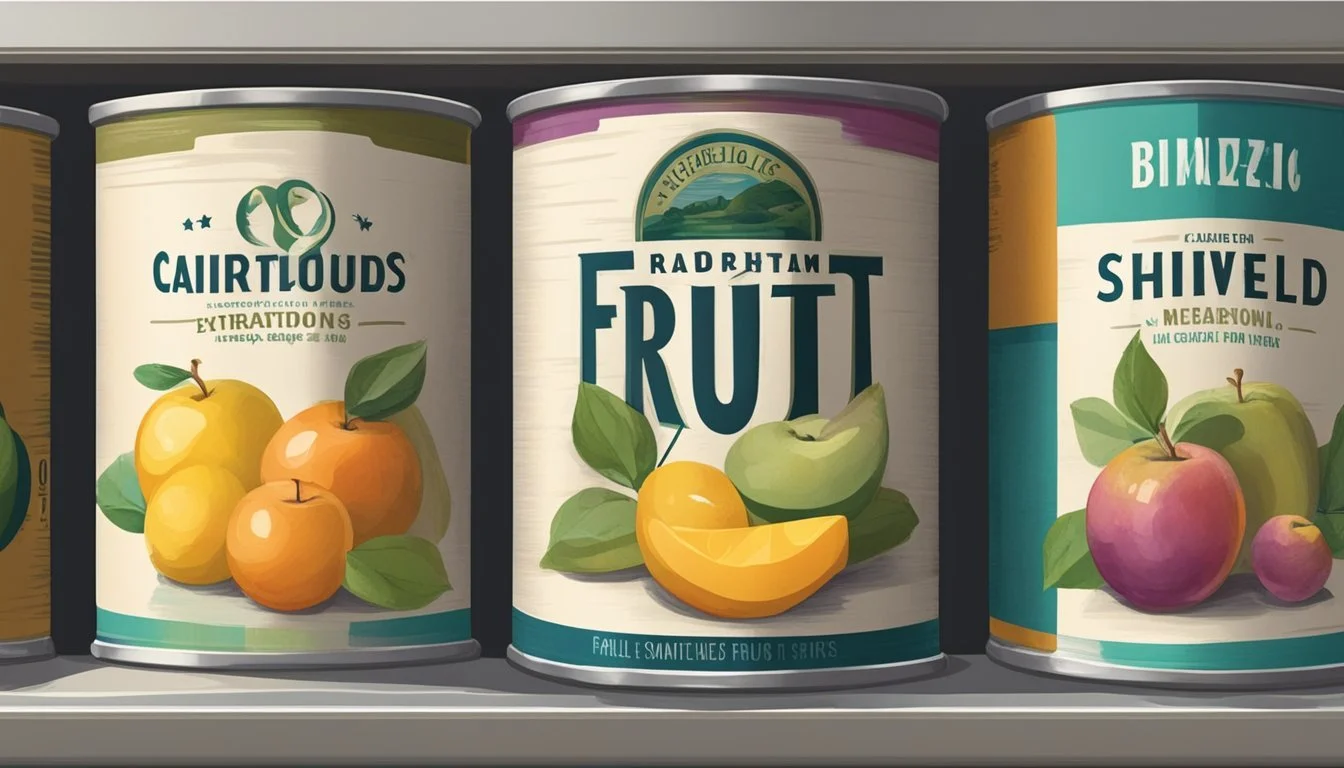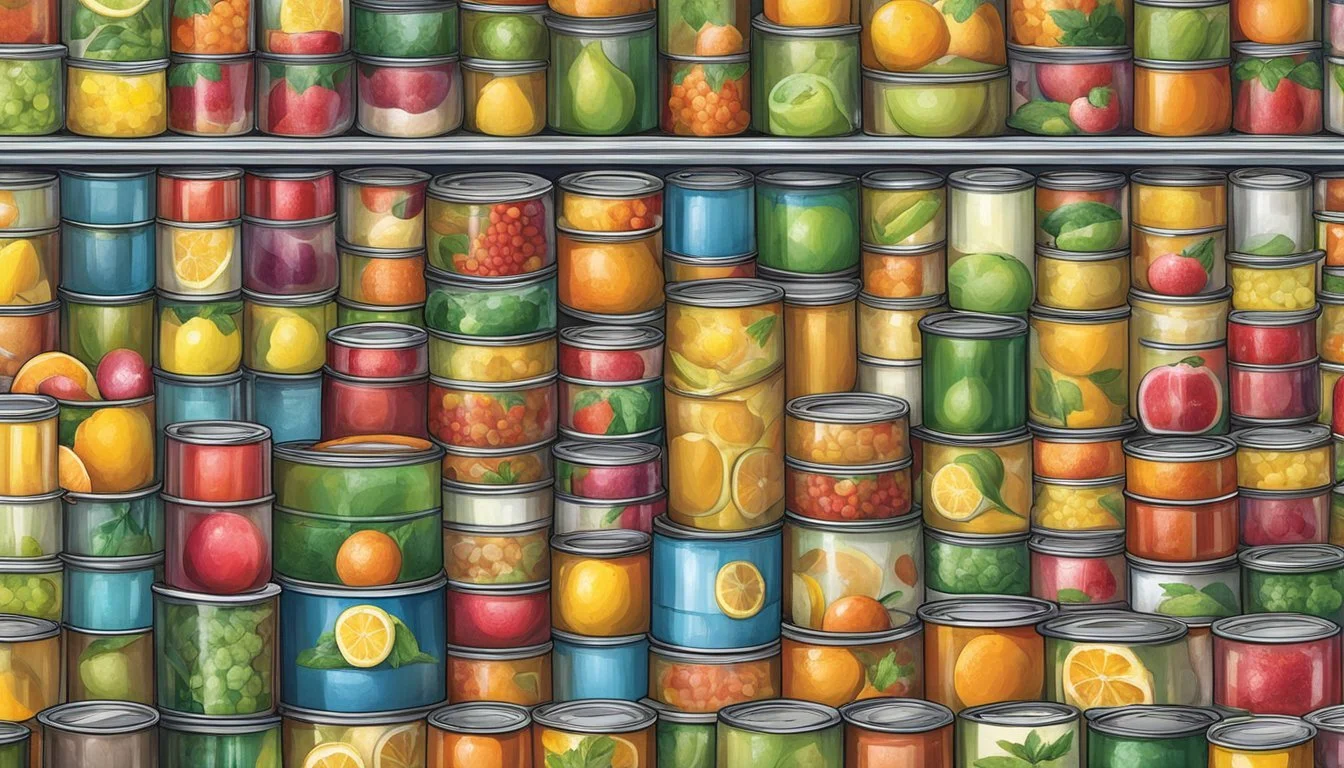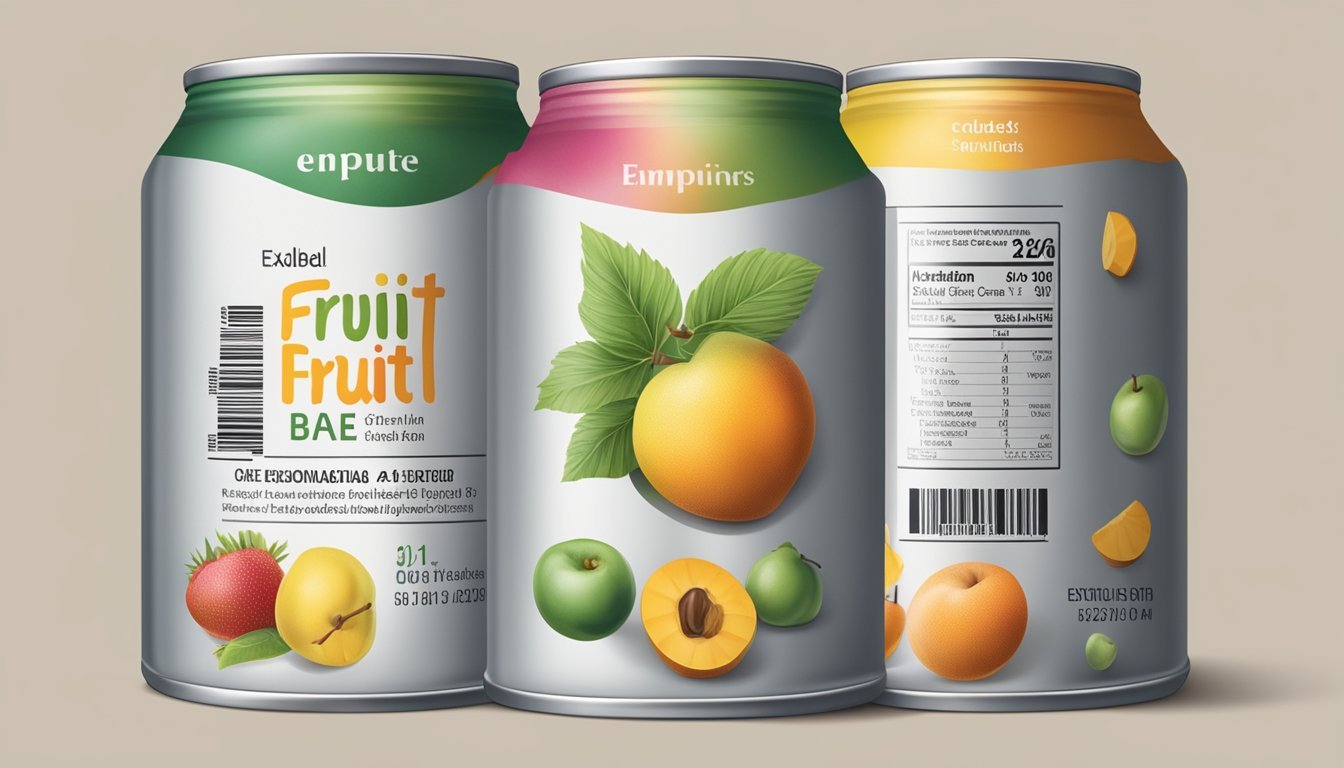Does Canned Fruit Go Bad?
Understanding Shelf Life and Storage Tips
Canned fruit is a staple in many households due to its long shelf life and convenience. While canned fruit can last for years, its safety and quality can deteriorate over time if not stored properly. Generally, canned fruit remains good for 1-2 years when unopened and up to 7 days once opened and refrigerated.
One might wonder if canned fruit can still be consumed after its expiration date. In some cases, if stored properly, canned fruit can last for two to four years past the expiration date. However, it is crucial to check for signs of spoilage, such as leaking, swelling, or dents in the can.
Proper storage is key to maintaining the quality of canned fruit. Keeping cans in a cool, dry place can extend their shelf life significantly, ensuring that you always have a delicious, safe option available in your pantry.
Understanding Canned Fruit
Canning is a method used to preserve fruits, ensuring they remain edible for extended periods. It involves various types and impacts nutritional content based on packaging.
The Basics of Canning Process
The canning process typically starts with selecting fresh fruits, which are then cleaned and often peeled or sliced. These fruits are placed in cans filled with liquid, usually water, juice, or syrup. The cans are sealed and then heat-treated to kill bacteria and enzymes that cause spoilage.
Key Steps in Canning:
Cleaning: Fresh fruits are washed to remove dirt and pesticides.
Preparation: Fruits might be peeled, cored, or sliced.
Filling: Cans are filled with the prepared fruits and a liquid medium.
Sealing: Cans are sealed airtight.
Heating: Heat treatment destroys microorganisms.
Varieties of Canned Fruit
Canned fruits come in different varieties depending on the type of fruit and the liquid used for preservation. The liquid can significantly affect the fruit’s caloric and sugar content.
Types of Liquids Used:
Heavy Syrup: High in sugar and calories; often used for flavor.
Light Syrup: Contains less sugar than heavy syrup.
Juice: Uses natural fruit juice for preservation.
Water: Minimizes added sugars and calories.
Common fruits canned include peaches, pears, pineapples, and mixed fruit. Each option provides a way to enjoy fruits year-round, though the nutritional content varies by packaging.
Nutrition in Canned Fruits
Canned fruits retain many vitamins and minerals such as vitamin C, vitamin A, and potassium, though some nutrients may diminish during the heat treatment. The type of packing liquid also influences the nutritional value.
Nutritional Facts:
Fruits canned without syrup are low in added sugars.
Heavy syrup increases calorie and sugar content.
Canned fruits can provide significant dietary fiber.
Typical Nutrient Content:
Vitamin C: Essential for immune function.
Vitamin A: Important for vision.
Potassium: Supports heart health.
Despite some nutrient loss, canned fruits remain a nutritious option when fresh fruit is unavailable, combining convenience with essential vitamins and minerals.
Factors Affecting Shelf Life
Various factors influence the shelf life of canned fruit, including the importance of expiration dates, storage conditions, and the intrinsic composition of the food itself.
Expiration Date Significance
Canned fruit often displays a best-by date rather than a strict use-by or expiration date. This indicates the period during which the product is expected to maintain optimal quality.
Manufacturers typically set best-by dates based on rigorous testing, ensuring that the fruit remains both safe and delicious under standard storage conditions. While it may still be safe to eat after this date, quality might decline.
Dents or bulges in the can are red flags. Such imperfections can signify compromised seals, which increases the risk of spoilage. Consumers should always check the condition of the can and adhere to provided dates for optimal safety.
Temperature and Storage Conditions
Proper storage is critical. Canned fruit should be kept in a cool, dry place to maximize its shelf life. Temperature fluctuations can affect both the can and its contents, potentially leading to compromised seals and spoilage.
Storage areas should maintain a stable temperature below 85°F (29°C). Avoid areas prone to moisture, as this can cause rust and degradation of the can over time. For opened canned fruit, refrigeration is essential and should be consumed within 7 days for best quality.
Consistently cool and dry conditions help in preserving the integrity and taste of the canned fruit, ensuring it remains shelf-stable for extended periods.
Canned Food Composition: Acid vs. Low-Acid
The acidity level of canned fruit impacts its shelf life significantly. High-acid foods, such as pineapple and canned citrus, have a natural preservation advantage, often lasting up to 18 months to 2 years unopened.
Low-acid foods, including certain mixed fruit cocktails, tend to have a longer shelf life up to 5 years because they are less prone to chemical changes that affect flavor and texture. However, they require proper processing during canning to inhibit bacterial growth effectively.
Understanding the type of fruit and its acidic nature can help in predicting its durability, guiding both storage practices and consumption timelines. Keeping an eye on these factors ensures that canned fruit retains its quality and safety throughout its shelf life.
Detecting Spoilage
Identifying spoiled canned fruit involves observing visual and olfactory signs, as well as recognizing chemical changes like leaking that compromise food safety.
Visual Inspection: Bulging and Dents
Canned fruit should maintain a good condition with no signs of damage. Bulging or dents on cans indicate potential issues. Bulging suggests gas production by bacteria, compromising the vacuum seal and indicating spoiled contents.
Rust accumulation also signals potential spoilage, as it can weaken the can and allow bacteria to enter. Always check for any swelling or deformity, ensuring cans remain intact and safe for consumption.
Olfactory Signs: Smell of Spoilage
The smell is a key indicator of spoilage. A can emitting an off odor is likely contaminated. Recognize smells like mold or sourness, which signal bacterial activity or mold inside the can.
A fresh, proper vacuum-sealed can of fruit should not have any unpleasant smells. If there's a smell emanating when the can is opened, it should be discarded immediately to avoid any safety risks.
Chemical Changes and Leaking
Leaking or any liquid seeping from a can is a critical sign of spoilage. This indicates the can's integrity has been compromised, allowing bacteria to enter. The liquid may carry toxins or harmful microorganisms, posing a significant food safety risk.
Monitor for any chemical changes such as altered color or texture of the fruit inside, which may suggest spoilage even if the can appears visually intact. It's essential to discard any leaking or spoiled cans to protect health.
Health Risks and Food Safety
Canned fruit can pose certain health risks if not stored or handled properly. It's important to know how to identify potential hazards like botulism and take steps to prevent food poisoning.
Botulism and Canned Goods
Botulism is a severe form of food poisoning caused by the toxin produced by Clostridium botulinum bacteria. This bacteria thrives in low-oxygen conditions, making canned goods vulnerable if not processed correctly.
Signs of botulism contamination in canned fruit include bulging cans, leaks, or a foul odor upon opening. Consumption of contaminated fruit can lead to symptoms such as blurred vision, muscle weakness, and difficulty breathing.
Proper canning and storage techniques are critical to minimize health risks. Always inspect cans for damage before use. If there's any doubt about its safety, it's best to dispose of the can.
Food Poisoning Prevention
To prevent food poisoning from canned fruit, always follow safe handling practices. Store canned goods in a cool, dry place to maintain their integrity.
Visual inspection is essential; check for rust, dents, or swelling. Ensure the can lid is intact and shows no signs of tampering.
When opening the can, listen for the characteristic release of pressure. Poor storage or contaminated tools can introduce bacteria, posing a risk. Always use clean utensils and practice good hygiene.
Key Points:
Store cans properly.
Inspect for signs of damage.
Use clean utensils when handling.
Preservation and Quality Maintenance
Preserving canned fruit effectively involves storing it under optimal conditions and recognizing the signs of quality and freshness. This ensures that the fruit remains safe and enjoyable to eat.
Optimal Conditions for Longevity
Canned fruit should be stored in a cool, dark place. Ideal temperatures range from 50°F to 70°F. Exposure to heat and light can deteriorate the quality, reducing shelf life.
It is crucial to keep canned goods commercially sterile and sealed properly. Once opened, refrigerate the remaining fruit in a separate airtight container to maintain food quality. Refrigerated canned fruit can last up to 7 days.
Avoid freezing canned fruit while it's still in the can, as this can cause the can to bulge or even rupture. If needed, transfer the fruit to a freezer-safe container for prolonged storage.
Signs of Freshness and Quality
Freshness can be gauged by examining the can and its contents. Look for signs of spoilage such as rust, dents, or bulging in the can. These can indicate potential contamination.
When opening the can, ensure there is no unpleasant odor. The fruit should retain its color and texture. Discoloration or an off-putting smell suggests the fruit has gone bad.
For the highest food quality, the canned fruit should still appear vibrant and juicy. If the liquid inside is murky or the fruit feels mushy, it's best to discard it. Following these guidelines helps maintain the freshness and safety of canned fruits, keeping them enjoyable and convenient.
Managing and Utilizing Stored Canned Fruit
Properly managing and utilizing stored canned fruit can help reduce food waste and lower food costs. Utilizing leftovers and incorporating them into innovative recipes ensures delicious and nutritious meals.
Making the Most of Leftovers
To minimize waste, it is crucial to handle leftovers from canned fruit efficiently. Once opened, transfer any unused fruit to an airtight container and refrigerate. Consuming refrigerated leftovers within 7 days ensures freshness and food safety.
Freezing is another effective option. Place leftover fruit in a resealable bag, remove excess air, and date it before freezing. This method can extend the fruit’s shelf life by several months.
Consider donating surplus canned fruit to local food pantries. This prevents waste and supports community members in need.
Innovative Recipes and Ideas
Canned fruit can elevate everyday dishes. Try adding sliced canned peaches to oatmeal or yogurt for a refreshing breakfast.
Create a quick fruit salsa using canned pineapple, combining it with diced red onion, cilantro, and lime juice. This can be served with grilled fish or chicken.
In baking, incorporate canned fruit into muffins, breads, or cakes for added moisture and flavor. For desserts, layer canned fruit with yogurt and granola to make parfaits.
These ideas show that with a bit of creativity, canned fruit can be deliciously repurposed, helping to minimize food waste and diversify meals.
Handling Expired Canned Fruit
Expired canned fruit is not always unsafe, but handling it with caution is key. This involves knowing when to keep or dispose of it and how recycling can reduce waste.
When to Keep and When to Dispose
Not all expired canned fruit is spoiled. The quality may decline, but it remains safe if there are no signs of spoilage. Signs to look out for:
Leaking cans
Swollen cans
Dented or bulging cans
Unusual odors or appearances after opening
If any of these signs are present, it is best to dispose of the product to avoid foodborne illness. Proper storage can extend the life of canned fruit beyond its "best by" date. Storing cans in cool, dry places helps maintain their safety and quality.
Recycling and Reducing Waste
Recycling cans from expired fruit helps reduce waste effectively. Metal cans are widely recyclable, contributing to environmental sustainability. Before recycling, ensure the cans are emptied and rinsed.
Alternative uses for expired canned fruit:
Composting non-spoiled expired fruit can enrich soil
Repurposing in non-food projects like compost for gardening
Avoiding food waste starts with proper inventory management, ensuring that older cans are used first. This helps reduce instances of food spoilage and waste. Reducing food waste not only saves costs but also benefits the environment.
Beyond Consumption: Alternative Uses
Canned fruit, often appreciated for its convenience and long shelf-life, offers various creative non-food applications that can be both practical and ingenious.
Creative Non-Food Applications
Household Cleaners
The syrup or juice from canned fruit, especially when mixed with ingredients like white vinegar or salt, can create an effective natural cleaner. For instance, a mixture of syrup and white vinegar can be used to polish stainless steel, while combining with salt can help remove rust from metal surfaces.
Beauty and Skincare
The natural acids and sugars in canned fruit can be beneficial for skin care. For example, mashed fruit can be used as a facial mask to exfoliate the skin gently, just like honey-based masks. The moisturizing properties of the syrup can serve as a unique ingredient in homemade hair conditioners.
Crafts and Decor
The vibrant colors of canned fruit pieces can be used in arts and crafts projects. From making fruit stamps to creating colorful decorations, the possibilities are endless. Kids love using fruit slices as stamps in their artwork, making for a fun and creative activity.







